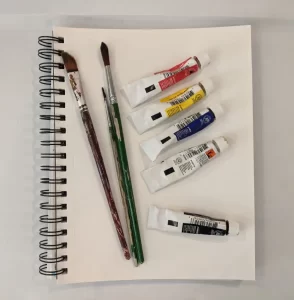Wonder what is the best way to clean your acrylic paint brushes? You have come to the right place? In this article, I’ll share tips on proper care for acrylic paint brushes, including how to clean them and dispose of their rinse water.
For optimal cleaning of acrylic paint brushes, rinse them periodically while painting. Use a two-jar setup and rag. Swirl brushes in the first jar, and wipe. Rinse in the second jar, and wipe again. Store brushes in a cool, dry place, protecting bristles. Dispose of rinse water properly by using paint cleaning kits, cat litter, evaporation, or diapers.

~This post contains affiliate links.
Taking Care of the Paintbrush
If you’re into painting, you know how crucial it is to take good care of your brushes. It’s not just about prolonging their life – it’s about getting the best possible results in your artwork.
As a beginner, I was so excited about the actual painting process that I completely overlooked the importance of brush care, and my poor brushes suffered the consequences, as you saw in the picture above. But hey, we all learn from our mistakes, right?
That’s why I wanted to share with you what I’ve learned so far about proper brush care. In this post, I’ll cover everything you need to know about cleaning and caring for your acrylic paint brushes. As a bonus, I also include ways to properly discard acrylic rinse water and why.
Secret to Top-Shape Artist’s brushes
In this section, we’ll discuss how to rinse your brush, and other tips for keeping your brushes in top shape. And as I learned the hard way, there is a better way to do it than just leaving the brush soaking in a jar of water.
Rinse and Repeat: Brush Care While Painting
Acrylic paint starts to dry in a few minutes. Thus, rinsing the brush while painting should be a habit. I think this is the most important thing if you want to prolong your brush’ life.
Though it may sound tedious at first, you will get so used to it that it will become automatic. It is much easier to get used to when using just one brush since you will always need to rinse before switching paint colors. It also helps to have a brush-cleaning setup while painting.
The ‘brush-cleaning setup’ should include 2 jars of water, and a rag (as you will see in the picture below).
Alternatively, you can buy brush cleaner like this.
Here’s how to do it.
- Swirl the brush in the first jar of water to remove most of the paint. Tap gently to remove excess water.
- Wipe it on the rag, following the direction of the bristles.
- Do the final rinse swirl in the second jar of water.
- Wipe it on the rag, following the direction of the bristles.
- Lay it flat while not in use.
- Repeat as often as needed.
Notes:
- Make sure to change the water when the 2nd jar turns murky.
- DO NOT discard the rinse water on the sink. Acrylic paint debris can build up and may clog drainage pipes. To avoid this, read the alternatives below.

Tips When Cleaning Paint Brushes
Here are more tips that will help prolong your brush life.
Don’t let the brushes soak in the water
When cleaning your brushes, you’ll want to avoid letting them soak in the water. This can misshape the bristles. This could even damage the ferrule (the metal part that holds the bristles in place) and the wooden handle. You’ve seen this in the damaged brushes pictured above.
Instead, rinse your brushes using the ‘brush cleaning setup’. Again, don’t forget to wipe after each rinse.
Do not over-clean
While it’s important to thoroughly clean your brushes after using them, you don’t want to overdo it. Cleaning too vigorously or using harsh chemicals can loosen the bristles from the handle.
Be gentle, don’t press the bristles too hard when painting
As with cleaning your brushes, you also have to be gentle when you paint with them. Avoid painting with excessive force. This is not just damaging to bristles, but it also makes the painting hard and a bit stressful. And Instead, use gentle motions to work the bristles into your painting surface.
Protect the bristles when storing
To further protect your brushes, avoid storing them bristles-up as they can fray. Ideally, you can use something like this brush case.
Store them in a dry, cool place
Keep them in a dry, cool place, away from direct sunlight and heat sources. This will help prevent bristles from becoming damaged or warped.
How to Discard Acrylic Paint Rinse Water
As promised, here are some ways to discard rinse water with acrylic paint. Using this method will avoid clogging the drain or staining the sink.
Isolate the paint particles
One way to make sure the paint doesn’t go down the drain is by using chemicals to isolate the paint particles. Luckily, we don’t need to be a chemist to do this. Paint Solids Cleaning Kit are available online.
This method is great if you paint a lot, otherwise buying the kit might be pricey. You can also source each of the materials as Rachel of The Dotting Center did on this youtube video tutorial.
Using a diaper
Sounds weird, but this works when you are on the go. Simply pour the rinse water into the diaper and then bag and dispose of it in the trash. A size 6 diaper can hold 0.7 liters of water.
Evaporating
Let rinse water dry outside in warm weather, away from children and animals. When all the water evaporates, throw the dried paint in the regular trash.
Use clumping cat litter.
Use clumping cat litter to absorb the rinse water and paint particles. Scoop out the clumps, put them in a bag, and throw them in the trash.
Final words
Taking care of your acrylic paint brushes can make a huge difference in the longevity of your brushes and the quality of your artwork. Proper brush maintenance will not only save you money but also give you better painting results.
I’ve pretty much covered all the important stuff about taking care of paintbrushes. If you’ve been keen on taking care of your brushes like I mentioned above, you won’t need to do much more. If not, I’ve got tips and tricks that can help revive damaged brushes in this blog post.
Happy painting!



